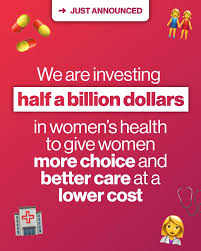FSI BLOG – Imagine a world where women’s health is not just a priority but a key driver of economic growth. Sounds ideal, right? The truth is, investing in women’s health is not just about well-being; it’s a trillion-dollar opportunity that can reshape economies, improve productivity, and drive innovation. Yet, for decades, it has remained underfunded. Why should we care? Because when women thrive, societies prosper.
Let’s explore why women’s health is a trillion-dollar investment, its economic and social impacts, and what we can do to close the gap.
Table of Contents
| Sr# | Headings |
|---|---|
| 1 | The Economic Impact of Women’s Health |
| 2 | Why Women’s Health is Underfunded |
| 3 | Breaking the Stigma Around Women Health |
| 4 | The Link Between Women Health and Workforce Productivity |
| 5 | Maternal Health: A Critical Investment |
| 6 | The Role of Technology in Women Health |
| 7 | Addressing Healthcare Disparities |
| 8 | Mental Health: A Silent Crisis |
| 9 | Preventive Healthcare: Saving Lives and Money |
| 10 | Women’s Health and Global Economic Growth |
| 11 | Investing in Women’s Health Startups |
| 12 | How Policymakers Can Drive Change |
| 13 | Public-Private Partnerships in Women Health |
| 14 | Breaking Barriers in Research and Innovation |
| 15 | Conclusion: The Way Forward |
The Economic Impact of Women Health
Investing in women’s health is not just a moral obligation—it’s a financial necessity. Studies show that closing the gender health gap could add $1 trillion to the global economy. Healthy women mean a stronger workforce, lower healthcare costs, and increased economic participation.
Why Women’s Health is Underfunded
Despite its importance, women’s health remains underfunded. Historically, medical research has prioritized men’s health, leading to gender disparities in healthcare funding. Many women’s health issues, from endometriosis to menopause, receive little attention, leaving millions to suffer in silence.
Breaking the Stigma Around Women Health
Women’s health issues are often stigmatized, leading to delayed diagnoses and lack of awareness. From menstrual health to reproductive care, societal taboos prevent open discussions. Breaking these barriers is essential to ensuring women receive the care they deserve.
The Link Between Women Health and Workforce Productivity
When women experience better healthcare, they take fewer sick days, are more productive, and contribute more to the economy. A healthier workforce means stronger businesses and a booming economy.
Maternal Health: A Critical Investment
Every year, thousands of women die due to preventable complications during pregnancy and childbirth. Investing in maternal health ensures healthier mothers and babies, reducing long-term healthcare costs and improving future generations’ well-being.
The Role of Technology in Women Health
Tech innovations are revolutionizing healthcare. From AI-driven diagnostics to femtech startups creating smart wearables for women health, technology is bridging the gap and providing better solutions.
Addressing Healthcare Disparities
Women, especially those in low-income regions, face limited access to healthcare. Investing in policies and programs that expand healthcare access can reduce mortality rates and improve quality of life.
Mental Health: A Silent Crisis
Women are more likely to experience mental health issues such as anxiety and depression, yet many do not receive proper care. Addressing this crisis requires increased awareness, better funding, and policy changes.
Preventive Healthcare: Saving Lives and Money
Preventive healthcare—such as screenings and early interventions—can save billions in treatment costs. Encouraging women to prioritize regular check-ups and screenings can reduce disease burden significantly.
Women Health and Global Economic Growth
A healthy female population boosts economic growth. Countries that invest in women’s health see higher GDP, improved education rates, and stronger economies.
Investing in Women Health Startups
The rise of femtech startups proves that women’s health is a booming industry. Investors are beginning to recognize the potential in funding innovations focused on female healthcare solutions.
How Policymakers Can Drive Change
Government policies play a crucial role in ensuring equal access to healthcare. By allocating more funds and supporting healthcare reforms, policymakers can bridge the gap in women health.
Public-Private Partnerships in Women Health
Collaboration between governments, private companies, and NGOs can drive significant improvements in women healthcare access and innovation.
Breaking Barriers in Research and Innovation
Medical research must include more women in clinical trials to create effective treatments. Historically, women have been underrepresented, leading to gaps in medical knowledge.
Conclusion: The Way Forward
Women’s health is more than a moral issue—it’s a trillion-dollar opportunity that can transform economies and societies. Investing in healthcare solutions for women means investing in a brighter, more prosperous future for all. It’s time for policymakers, businesses, and individuals to recognize the power of prioritizing women health.
FAQs
1. Why is investing in women’s health important?
Investing in women’s health improves economic productivity, reduces healthcare costs, and enhances overall societal well-being.
2. How does women health impact the economy?
A healthier female workforce means fewer sick days, higher productivity, and a stronger global economy.
3. What are the biggest challenges in women healthcare?
Underfunding, lack of awareness, stigma, and limited research are major obstacles preventing women from receiving adequate healthcare.
4. How can technology improve women’ health?
Innovations like AI diagnostics, wearable health trackers, and femtech solutions provide better, more accessible healthcare for women.
5. What can individuals do to support women health?
Advocating for policy changes, supporting women-led healthcare startups, and raising awareness can drive positive change.
Investing in women health isn’t just about equality—it’s about unlocking economic potential, innovation, and a healthier world. The time to act is now!
